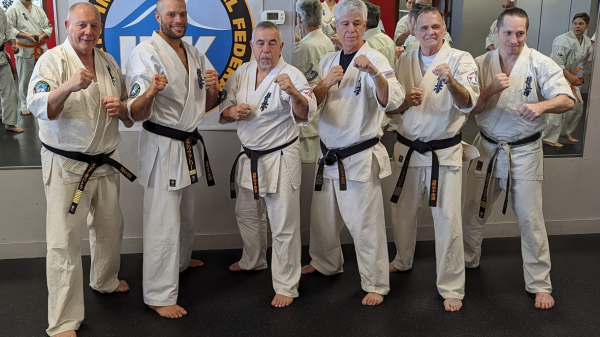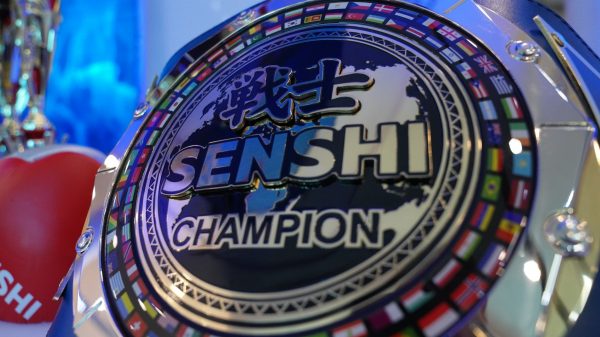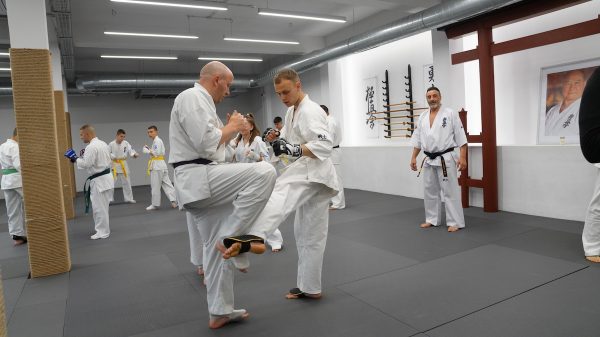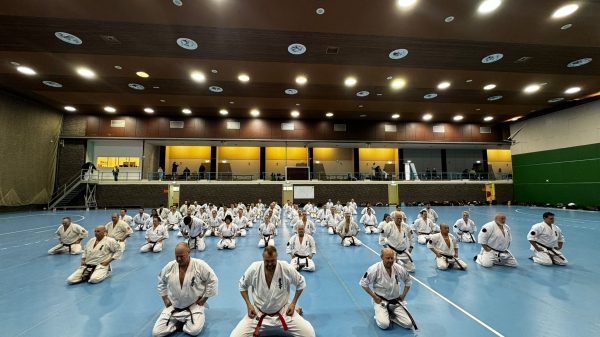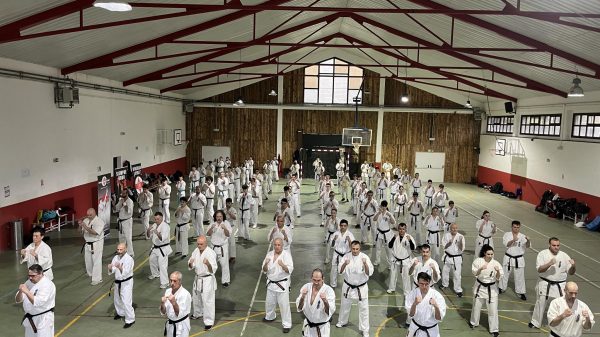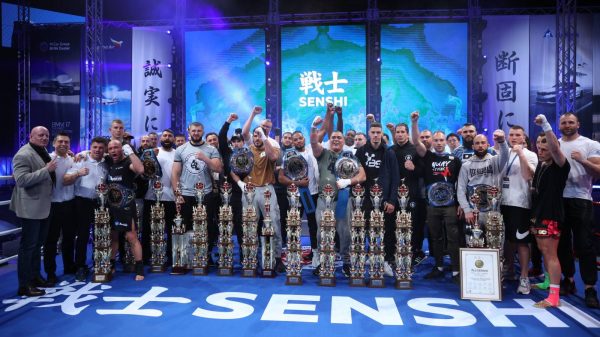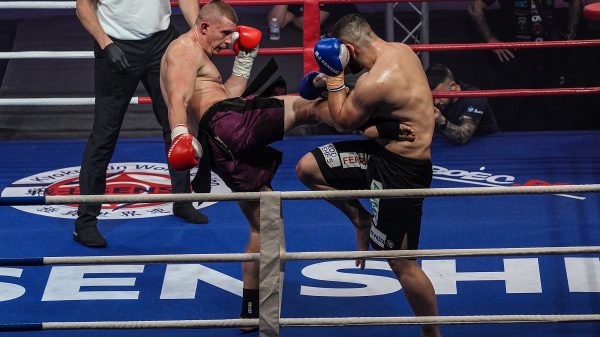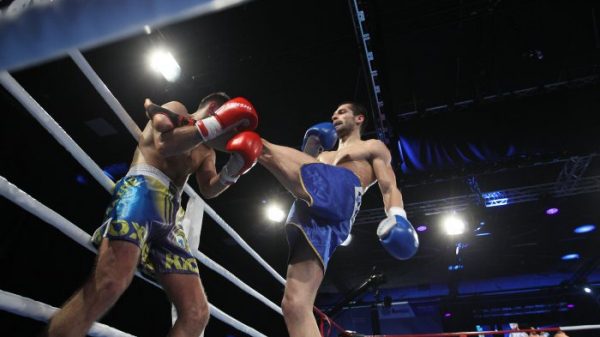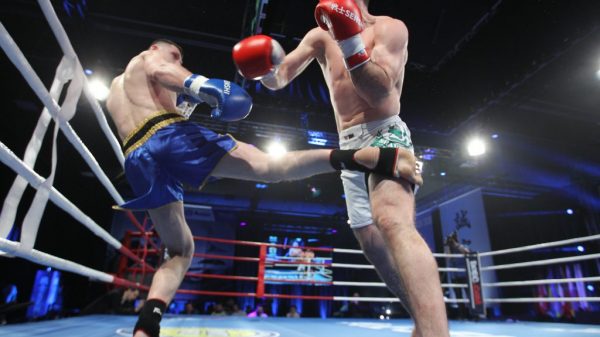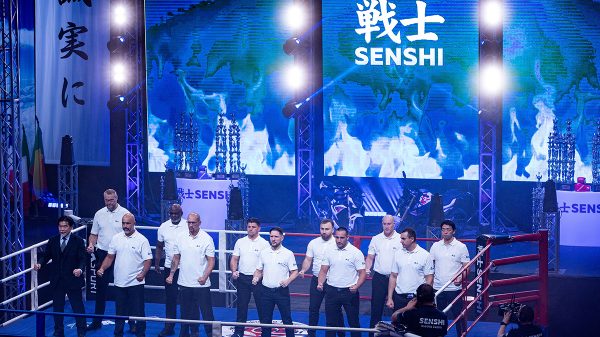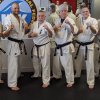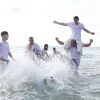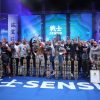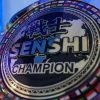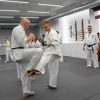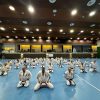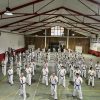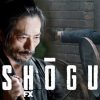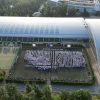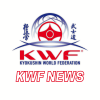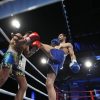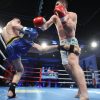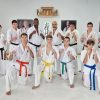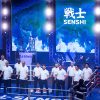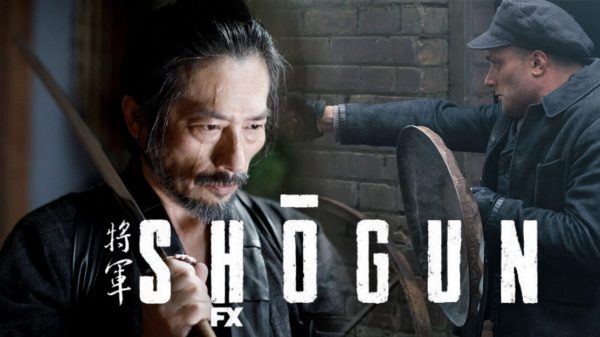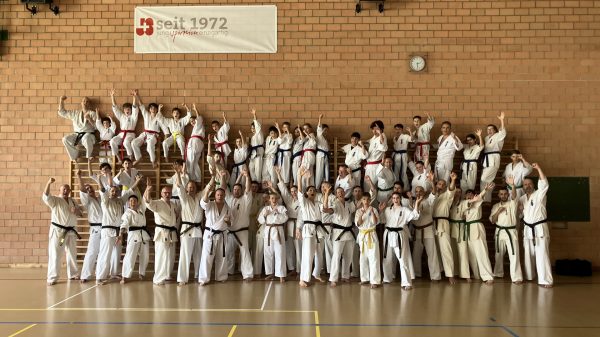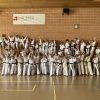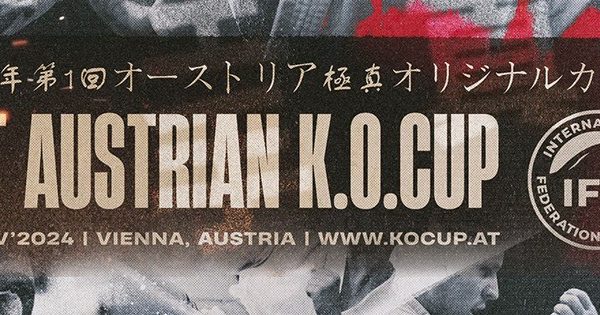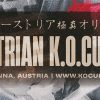Mas Oyama in America – part 3 of 3 – part 1, part 2
By Graham Noble: This article, or historical essay, is part of the book I am trying to write on the history of karate and its masters. This is one section of the chapter on Mas Oyama, his Kyokushinkai style, and his influence on karate history. It’s about his 1952 tour of the USA and it relies heavily on translations from Japanese material: I have to thank Mitchell Ninomiya for his translation of the old “Ooru Yamimono” article, and especially Brian Sekiya, who translated all of the other Japanese material. There wouldn’t really have been a finished piece without Brian’s input. Thanks also to Joe Lopez for his reminiscence of Mas Oyama in New York, to the OldTime Strongman site for the rare old newspaper reference Sebastian Miller , “The Rock Breaker”, and to Charles Goodin for putting this long article on his site, in full.
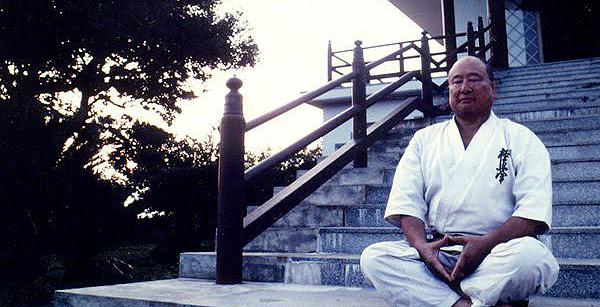
5. Life and Legend
When I first started looking at all this I wondered if Mas Oyama had ever harboured ideas of becoming a professional wrestler, and whether this early 1952 tour was some kind of tryout for a pro-wrestling career. In fact, it’s clear from Kokichi Endo’s account that Oyama was devoted to his karate and never considered a career in wrestling. His brush with pro wrestling however did seem to influence him in several ways. Kokichi Endo’s inside knowledge was that pro wrestling matches were works (prearranged) and that pro wrestling was a living, a business, whereas Oyama’s stories of his challenge matches played to the assumptions of a large number of Japanese that pro wrestling bouts were actually real. But the early struggles of the Ultimate Fighting Championship, the UFC, demonstrated just how difficult it really was to hold a bare knuckle no holds barred (almost) contest in the USA, or a “shinken-shobu” (death match) as Oyama called it. And as Joseph Svinth pointed out, “As post war professional matches are legally termed exhibitions, the intentional causing of serious injuries is proscribed by law. Therefore mayhem is a possible charge for breaking a policeman’s ribs. At a minimum, workmen’s compensation would have wanted Oyama to pay for the policeman’s time lost at work and medical bills”. Of course if, as Mas Oyama once suggested, his opponent had died after their challenge match, it’s hard to understand how he could have escaped criminal investigation. Joe Svinth also wondered what kind of medical or legal waivers were signed for these contests before anyone entered the ring.
[bctt tweet=”I would like to see the next generation of Japanese karateka who…” username=”kwunion”]
The experience of travelling across America, and his involvement with the pro-wrestling world, must have had some influence on Mas Oyama. At the least it may have given him some ideas of what we now call promotion and marketing. His experience of the USA also made him aware of the potential for the international development of karate, although he recognised that in the future karateka would have to raise their game. In 1956 he told Hiroshi Kinjo that “I would like to see the next generation of Japanese karateka who can compete on the world level and show the world the level of skills and ability of true karateka. In order to achieve such a goal one must have a great deal of dedication and intense hard work. The true karateka must possess power, speed and agility. . . I’m looking forward to seeing such younger generations of karateka”. And he was realistic about the size and physical power of the wrestlers and other athletes he had met in America. At the Oyama dojo a few years later Eiji Yasuda, one of the assistant instructors, mentioned that he wanted to lose 10 pounds or so to get more speed. But, Yasuda remembered, “Oyama sensei didn’t agree with me. He said we had to power up with our training. When I said ‘Sensei, if you put too much muscle on the body you’ll lose speed’, he said ‘You can say that. But when you hit your opponent you should have enough power to knock him over two or three metres. Without that kind of power you wouldn’t be effective in America’ “.
In that 1956 interview with Hiroshi Kinjo, Oyama was quite correct and modest in his answers and when he was asked about his experiences in America he replied “I do not wish to talk about my challenge matches in America. I do not wish to be a hero of some sort. That I believe is an outdated idea . . . For the sake of our students I wish I could eliminate all the stories of fights and challenge matches from the books. When I read books on karate, all they write about are fight stories. Publishers are only thinking about their own financial gain and I believe that is harmful to students”. And although much later in “The Kyokushin Way” (1979) he could write that “I am convinced that, as long as I am permitted to use karate I am unbeatable in unarmed conflict”, and that “When I was in my prime I don’t believe there was a man alive I could not defeat with a single reverse punch“, in the 1958 edition of “What is Karate?” he was much more modest about his victories. “What I experienced during my tour of the States” he wrote, “was that pro-wrestling, boxing and judo are no match for karate. I discovered that my opponents had no preliminary knowledge of karate at all. If they had known the art of attack and defense of karate I might have been defeated since their hands and feet are much longer than mine. In America the wrestlers are mostly giants. My arm is 17 inches round and I am proud of it. On the other hand I am 5 feet 7 inches high and weigh 190 pounds only. But fortunately we karateka have a powerful punch that can knock down any opponent by one stroke. And also we have our own art of kicking that takes our opponent by surprise. If these American wrestlers would learn karate they would be sure to show terrible power. This is true because like other competition, victory or defeat by karate is also dependent largely upon physical strength and speed”.
In the completely new, 1966, edition of“What is Karate?” (1966) Oyama never referred to his challenge matches in America, nor did he mention them in his other technical books “This is Karate” (1965) or “Advanced Karate” (1970). But then in the early 1970s a great Kyokushinkai promotion exercise began, particularly from Ikki Kajiwara and his brother Hisao Maki and the comic strip “Karate Baka Ichidai”. Then there were the three movies supposedly based on Oyama’s life starring Sonny Chiba, and autobiographical books such as “Tokon” and “Kenka Karate Sekaini Katsu” so “from being a virtually unknown figure to the general public, Mas Oyama became something of a super hero” and the stories of his challenge fights resurfaced, though now in an exaggerated form. . . . and it became ever more difficult to sort out truth from legend. Back in 1998 I spent two days interviewing Jon Bluming who had started training with Oyama in Japan in 1959. Jon had been a favourite pupil, to such an extent that in 1965 he had been graded to 6th dan, making him second only to Oyama himself in the Kyokushinkai organisation. Later the two men drifted apart, but Jon still remembered the Mas Oyama of the old days with affection and respect, and when I asked him about Oyama’s death he choked up and tears came into his eyes.. But one thing he didn’t agree with was the exaggerated stories that started to appear in the 1970s, some of them actually involving him. “The stories just got better and better all the time” Jon said, “and finally, to top it all off, one of his (Oyama’s) students who was a commercial artist, put together a comic book about Oyama, who was with ‘The Animal From Amsterdam’ (Bluming), and man, they really went to the yakuza and knocked them all out and so on. — Unbelievable!”
[bctt tweet=”The stories just got better and better all the time” username=”kwunion”]
But then too, many things are just not reported. A few years ago, for example, I tried to establish the fight (boxing) record of Lenny McLean, “The Hardest Man in Britain”. McLean became a well known figure after the publication of his autobiography “The Guv’nor” in 1998. He had a number of fights in the ring yet I found it impossible to get his full record. His one time manager Frank Warren said that McLean had 12 fights, losing 5, though even these figures are uncertain. And the reason for this is that the fights were in “unlicensed boxing”, that is in bouts not recognised by the sports governing body, the British Boxing Board of Control. Because of that they were not reported in the newspapers, and crucially they were ignored by the trade paper “Boxing News”. For the most part they weren’t filmed so for many of McLean’s boxing matches no record seems to exist. For his many fights on club doors and in the street there is simply no record at all.
So just because there are no reports of any Mas Oyama fights in the USA doesn’t mean they didn’t happen, but it does make verification impossible, and that, and the testimony of Kokichi Endo, raises major doubts. When Oyama wrote that his opponents were “famous heavyweight boxers”, it is reasonable to ask exactly who they were. We should be able to pick their names out of the heavyweight ratings which appeared month after month in magazines such as “The Ring” and “Boxing and Wrestling” – but we can’t. The supposed record of 270 victories in the ring is simply not credible, although to be fair, it doesn’t seem that Oyama himself ever made that claim.
Those stories were an important part of the promotion and expansion of Kyokushinkai and they did inspire many of Oyama’s followers . . . but Kyokushinkai is a strong enough style now to stand up on its own terms. This was all a long time ago and I don’t suppose it matters now, except for purposes of historical accuracy.
6. Tameshiwari
After he returned to Japan after his 1952 tour, America must have remained in Mas Oyama’s mind because he returned there several times. There are references for example to visits in 1954 and 1960, but we don’t seem to have any documentation on these trips. During his 1962 stay he gave a demonstration at the North American Karate Championships at Madison Square garden. “Black Belt” reported that “The 8th degree Black belt of Kyokushinkai karate gave an impressive demonstration, crushing granite rocks, snapping bricks and boards with his bare hands. As black belt Frank Fanzone made repeated lunges at him with a butcher’s knife Master Oyama twisted, blocked and chopped with many combinations showing how deadly his art could be in practice.” This event was also covered by the New York Times which called him “the toughest man in the world”. When Oyama returned in 1965 he again did a demonstration at the North American Tournament in New York. “Black Belt” was there again, reporting that “A highlight of the June tournament was the demonstration by Mas Oyama, who performed tensho kata (breathing and tension movements), broke planks and bricks, and startled all by cleaving the necks of two bottles that remained in place”.
[bctt tweet=”The 8 degree Black belt of #Kyokushinkai karate gave an impressive demonstration” username=”kwunion”]
During one of those New York visits, Joe Lopez, who was a Peter Urban student at the time, went to see Oyama taking a training session at Augustin de Mello’s karate school in Greenwhich Village. The lesson was mainly basics, powerfully done: Mas Oyama’s forefist thrust, Joe thought, “was like a piston”. Joe was also a participant at the Madison Square Garden tournament and he remembered Oyama going through two bricks with a shuto strike and then breaking another brick with a punch: his assistant held the top half of a brick in both hands and then Oyama hit it with his forefist, knocking the bottom half away while the other half remained in the assistant’s hands. When Joe went back into the changing rooms some karateka were there and they were trying to break some bricks left over from Oyama’s demonstration, and they couldn’t do it. After several tries Joe was able to break one of the bricks, but he remembered that these were genuinely hard bricks: they weren’t easy to break, and yet Mas Oyama was just punching right through them. That experience gave him a real respect for Oyama’s physical power.
“Strength and Health”, May 1954, in its column “Strongmen the World Over” had the following “‘Hard as nails’ would be a rather mild description of the fantastic punching power of the Japanese karate experts. Karate is truly a mayhem form of judo featuring violent blows. Smashing a 2 inch plank with a single blow of the bare fist is a routine stunt for a karate expert. In an exhibition performance in this country last year, one of the Japanese masters of this form of combat split a pile of five one inch boards with a blow delivered by his rock-like fist”. Although he wasn’t named, this was obviously a reference to Mas Oyama, so his 1952 visit did make an impression. Yet oddly, it seemed to pass over the head of much of the martial arts community — the judo community as it was then. Presumably this was because it was part of a wrestling promotion and was restricted to the professional wrestling circuit.
When karate was first introduced to the West one of its main attractions was breaking and instructors were invariably asked to demonstrate it. It was something that just used to fascinate people, and so in the early 1950s Mas Oyama’s breaking feats must have seemed amazing to the American public. According to Oyama, writing in 1965, “After a while in America our hands earned the name ‘the hands of a god.'” This seems to be the origin of the grandiose 1970s name for Oyama of “God Hand”. That term, however, doesn’t appear in any of the American newspaper and magazine clippings of the time.
[bctt tweet=”After a while in America our hands earned the name The hands of a God” username=”kwunion”]
He had been conscious of the effect that breaking had on people and he had worked hard on the techniques. In “This is Karate” he wrote: “After we had devised our own breaking methods we showed them to a very famous Chinese kempo master, who was awe-struck with admiration”. Oyama must have had some unusual training methods too because he also stated that “We were the first to break dogs’ necks with the knife hand and to rip the horns from some forty cows.” He wrote that people who could actually break three bricks with the knife hand were entitled to the name “master of the knife hand”, adding that “Anyone who can break more than two bricks with the knife hand could probably use the same technique to break the neck of a large dog. He could also rip the horn from a cow. Our own experience has taught us that it is possible to break a Japanese dog’s neck with one knife hand blow. We have actually done this many times, thought that was some years ago. The same is true of ripping the cow’s horn”.
Oyama had torn the horns of cattle and broken dogs’ necks but could he break more than two bricks? Oddly, there do not appear to be any photos of him doing so. In “What is Karate?” (1958) he simply wrote that he could “break two red bricks at a time if my condition will permit.” When Robert W Smith reviewed the new edition of “What is Karate?” in 1966 he pointed out that the well known Hung I-Hsiang of Taiwan could break three supported bricks (that is, resting between two supports), or two unsupported bricks: that is, bricks lying on a flat surface, which is obviously much more difficult. Hung did the breaks with a hammer fist. Typically, John Keehan, or “Count Dante” claimed to be the only man alive who could break two bricks lying flat. Steve Morris, the British martial artist, saw Robert W. Smith’s book “Chinese Master and Methods”, in which Hung’s feats were described, and he resolved to duplicate them. There is footage of Steve on the internet breaking two bricks unsupported with a hammer fist and three with an elbow. He is also shown in the British magazine “Combat” (1976) breaking three bricks unsupported with a palm strike. Frank Perry, a one time Kyokushinkai student of Steve Arneil would break three bricks with a knife hand in demonstrations. A lot of Korean Taekwondo instructors were good at breaking too, as were some the Chinese “hard chi-kung” practitioners. I haven’t looked into this in any detail, but there were probably quite a few people who could duplicate or better Oyama’s published brick breaking feats.
Of course, bricks and boards vary in strength so actually it’s difficult to make comparisons or judgements. Kokichi Endo recalled that Oyama could always break four or five boards in Japan but in the USA sometimes he could manage only one or two. He quickly learned which boards were the best for breaking and when he could he would buy up a supply and load them into the car they used to travel in. In “This is Karate” Oyama wrote that “When we were in Mexico we attempted to break three boards — each one inch thick — of a type of wood different from that to which we were accustomed. This wood was as hard as iron and had a grain so close that you could not even see it. Even one board would have been difficult to break, let alone three. At last we succeeded in breaking one, but the whole incident was a grim error.” Mexico can’t have been a wholly happy experience for him because a few pages later in the same book he also wrote that “We personally made a big mistake in Mexico twelve years ago by choosing the wrong type of brick”, adding the advice to “Avoid the types of bricks the Americans sometimes pave streets with, because they are as hard as iron and impossible to break with the bare hands”.
[bctt tweet=”Breaking objects with the hands and feet has probably existed in the eastern martial arts” username=”kwunion”]
Breaking objects with the hands and feet has probably existed in the eastern martial arts for hundreds of years. In Japan it certainly predated the introduction of karate in the 1920s. William Bankier, the strongman “Apollo”, wrote about the edge of the hand blow in his 1905 book “Jiu-Jitsu. What It Really Is”, adding that “Some of the Japs who made a study of this sort of thing have been known to actually break very large stones with their bare hand. To such an extent had these men developed the heel or side part of the hand that it almost became as hard as stone.” During his military service in France in World War 1, Bob Hoffman, the founder of “Strength and Health” magazine saw an example of breaking in Paris, of all places: “In France during the war, Bob Hoffman told me that he saw a Japanese sidewalk performer actually break slabs of marble with chop blows of his hand. The side of his hand was about half an inch thicker than a normal hand”. In 1940 the “Japanese American Courier” reported that “Marking its 34th anniversary the Tacoma (judo) dojo will hold its annual tournament Sunday afternoon at the Buddhist Church auditorium . . . Over 40 black belts are listed for action. An additional feature on the programme will be Masato Tamura’s ‘rock breaking’ demonstration via the ancient Japanese art of “kiai jutsu”. He will also oppose a quintet of picked black belts”. Tamura was a well known judoka who had got his third dan during Jigoro Kano’s visit to America in 1938. In none of these accounts, incidentally, is there any mention of karate.
One person who did duplicate some of Mas Oyama’s breaking was his pro-wrestler “older brother”,The Great Togo. Togo didn’t know anything about karate but he had seen how Oyama’s tameshiwara had amazed audiences. He had picked up some of the breaking techniques and as a boost to his wrestling career he proclaimed himself a karate expert. There remains a clip of “The Great Togo” from a 1950s TV show, and although he doesn’t show any proper karate technique he does break some wood, and then a stone with a knife hand strike.
When he breaks the stone he uses the same technique as Mas Oyama shows in “This is Karate”, that is, one end of the stone is held in the non-striking hand with the other end raised slightly above the hard supporting surface. When the knife hand strike is delivered the free end of the stone hits against the hard supporting surface and the stone breaks. That method can also be used for bricks, and as Count Dante explained, the stone, or brick, is actually broken by hammering it against another hard object.
Dante criticised Mas Oyama for breaking bricks in this way, calling it a “stunt method” of breaking. He considered it of little real merit and showed it as such in his booklet “World’s Deadliest Fighting Secrets”. Count Dante may have been viewed as a charlatan by many people in the martial arts, but one thing about him — he could break bricks. “I remember watching him break bricks,” Joe Lewis once recalled. “He’d lay two bricks flat on the ground, then he’d hit the top one and break both of them. He had hands like a woman, but he sure could slap through those bricks”.
Many years back, in the later part of the nineteenth century, there was a strongman called Sebastian Miller, who was known as “The Rock Breaker”. A report in the “Cambridge Jeffersonian” newspaper (Ohio) of 1 March 1899 stated that “A strongman has turned up in Philadelphia. He calls himself Sebastian Miller and a distinguished gathering of physicians and professors witnessed some of his feats of strength in the Pennsylvania hospital a day ago.
“Miller stripped to the waist in order that the physicians might see the workings of his gigantic muscles and he stepped to a light pine table on which were placed several cobblestones.
“A large stone was held in place and Miller, giving three powerful swings with his right arm, brought his fist down on the stone. The first blow cracked it, the second broke it, and the third shattered it into bits. In doing this Miller wrapped a piece of cloth around his hand to protect it from being cut.
“But Miller’s strength is not all in his arms. With a harness he has raised 3,500 pounds, and with his hands he can lift 1,800 pounds. With three successive blows of his fist he has broken a block of Quincy granite 5 feet long, 4 feet broad, and 6 inches thick”.
“His method” wrote David Webster, “was to lay a stone on a table and hold another a little above it, then smash down on the top one (with his bare fist), the impact breaking the weaker stone”. A 1900 article in Bernar McFadden’s “Physical Culture” magazine was probably referring to Miller when it stated that “Some years ago a ‘strong man’ travelling trough the country created quite a sensation by breaking rocks with his fist. But, strictly speaking, he did not break them with his fist. He would hold a stone a little above another stone, then he would hit the upper one hard with his right fist, which was bandaged, and break it really by knocking it against the lower one”.
[bctt tweet=”His method was to lay a stone on a table then smash it with his bare fist” username=”kwunion”]
Sebastian Miller’s stone breaking method, then, was similar to the one used by Mas Oyama a half a century later. Still, I can’t imagine it was easy to smash a cobblestone to pieces, or break a six-inches thick block of granite. In 1891 Miller had a strongman contest with Louis Cyr, who was then generally acknowledged as the strongest man in the world. In those days each contestant would choose a series of lifts or feats of strength to be undertaken by both men. Miller was defeated relatively easily on the lifting, but Cyr couldn’t break a stone, which apparently was one of Miller’s chosen feats. Sebastian Miller also featured briefly in Charles Morrow Wilson’s history of early American Wrestling, “The Magnificent Scufflers”. He once had a wrestling match with lightweight Ed Decker who, according to Wilson, beat him with a shoulder throw, knocking him unconscious after one and a half minutes of wrestling. Decker was heavily outweighed, and he knew about Miller’s ability to break cobblestones, but he made the comment that “Rocks don’t think” . . . . And I’ve often wondered whether that was where Bruce Lee, who was a voracious reader of books on combat sports, got the idea for his famous “Boards don’t hit back” quip in “Enter the Dragon”.
In the 1950s George Jowett, who was a prolific writer on anything to do with physical culture, advertised a course called “How to Break a Rock With Your Bare Hands”. This seems to be extremely rare now; I haven’t seen it and cannot say whether it had anything to do with karate or was some kind of continuation of the Sebastian Miller tradition of breaking. Very occasionally you would read about other professional strongmen who included breaking feats it in their act. There was Emil Bregulla, who was active around the early 20th century and who would break rocks with his hands. Interestingly, like Mas Oyama, Bregulla also used to wrestle bulls. Judging by the posters for his act, Al (Aloysius) Marx, another old time strong man would smash stones with his fists. Back in the early 1970s there was a British strongman called Duval (?) who used to smash coconuts as part of his performance. And the same year that Oyama made his American tour, “Strength and Health” (March 1952) had a short feature on an entertainer called “Guss, The Man With Iron Hands”. He did various feats of hand strength including ripping two packs of playing cards in half, tearing tennis balls apart — and chopping a broomstick into short sections with the edge of his hand; a knife hand blow, in effect. According to David Webster’s reference book on strongmen, “Sons of Samson”, “Guss” was Gustav Grimm, a one time partner in a strength and juggling act, who after the war went solo with his “iron hands” act. He worked in the circus and variety and Webster wrote that he could break thick wooden planks with the edge of his hand. He seemed to have been of average build and if the date given for his birth (1886) is correct, then he would have been 66 years old when “Strength and Health” featured him. Apparently he had worked out his act without being aware of karate. Probably because of that he didn’t break bricks or stones, but if he had known of Oyama’s breaking methods he might well have been able to duplicate them after a short period of training.
But anyway, by the late 1950s it was karate that was associated with breaking wood, bricks and stones, and the image of karatemen as killers with hands of stone took some time to die out. That old idea can be seen in the 1962 movie “Karate, Hand of Death”, which embodied all the clichés of the time, such as that a karateka had to register his hands with the local police. It is an absurd film, but it’s fun to watch now, and in fact it’s redeemed by some nice footage of the old JKA honbu dojo. More in the mainstream was Samuel Fuller’s “The Crimson Kimono”, (1959), a murder mystery set in Los Angeles. There is a karate sub-plot here and one of the characters is “Mister Shuto . . . a formidable Korean”, clearly modelled on Mas Oyama, or at least a memory of him. I haven’t seen this film for years, but if I recall correctly Mister Shuto is finally subdued by the two detectives investigating the case, but not before he has demolished half a saloon bar with his karate chops.
This was the idea people had of karate. Did it do any harm to the art? In the long run I don’t suppose it made any difference at all, and maybe it was unavoidable anyway. It certainly stirred people’s interest and in that way it may have even been beneficial to the spread of the art. As people learned more about karate and began to train, they learned that it needed a lot of work, and the sensationalism fell away. Oyama himself always pointed out that karate was not about breaking, but he did believe it was an important part of the whole art. In “This is Karate” he wrote that “One who, though skilled in the forms and in practice fighting, can manage only a little of the karate stone or brick techniques, cannot be considered a karate teacher . . ..Performing the stone breaking techniques with a correct understanding of them and their purpose is absolutely essential to the performance of karate itself. If the formal exercises and the practice fighting are the parents of karate, the stone breaking techniques are the child. The basic formal exercises without the stone breaking techniques are like a chestnut tree that bears no nuts. These techniques are essential to the other basic forms because they are the device with which we measure the karate practitioner’s real strength. Stone breaking techniques are an essential element in our training”.
Oyama himself knew only too well the effect breaking demonstrations had on the audience, and they were the biggest feature of his 1952 tour, but in his later visits to the USA he came to teach: the showbusiness elements that had been such a part of that first trip were largely put to one side and the emphasis was on hard training.
[bctt tweet=”Stone breaking techniques are an essential element in our training” username=”kwunion”]
In those later years he was concentrating on developing and expanding his style of karate. But in 1952 Mas Oyama was still trying to make his name as a karate expert and shortly after he returned to Japan from the USA he began training for his most famous feat, a public contest against a bull . . . But that is another story.


